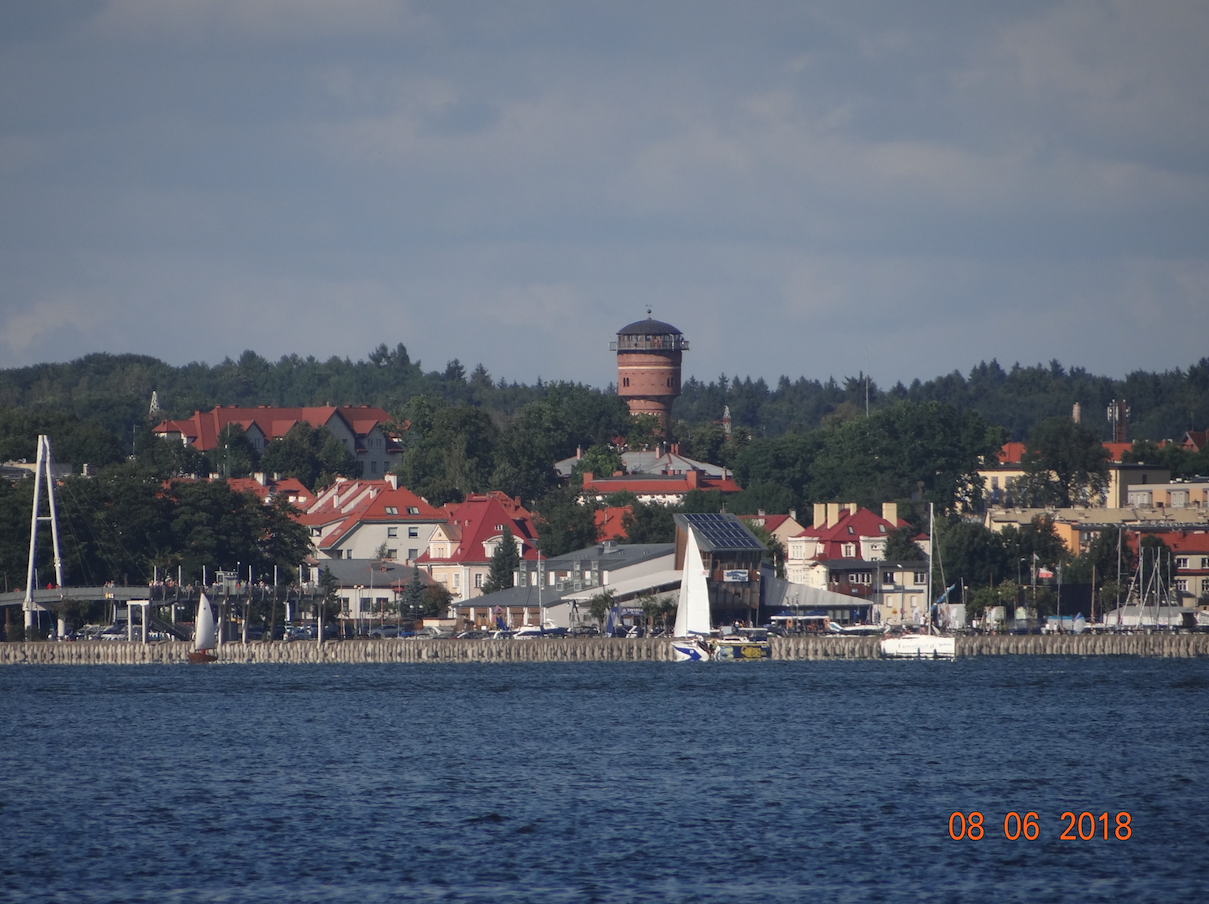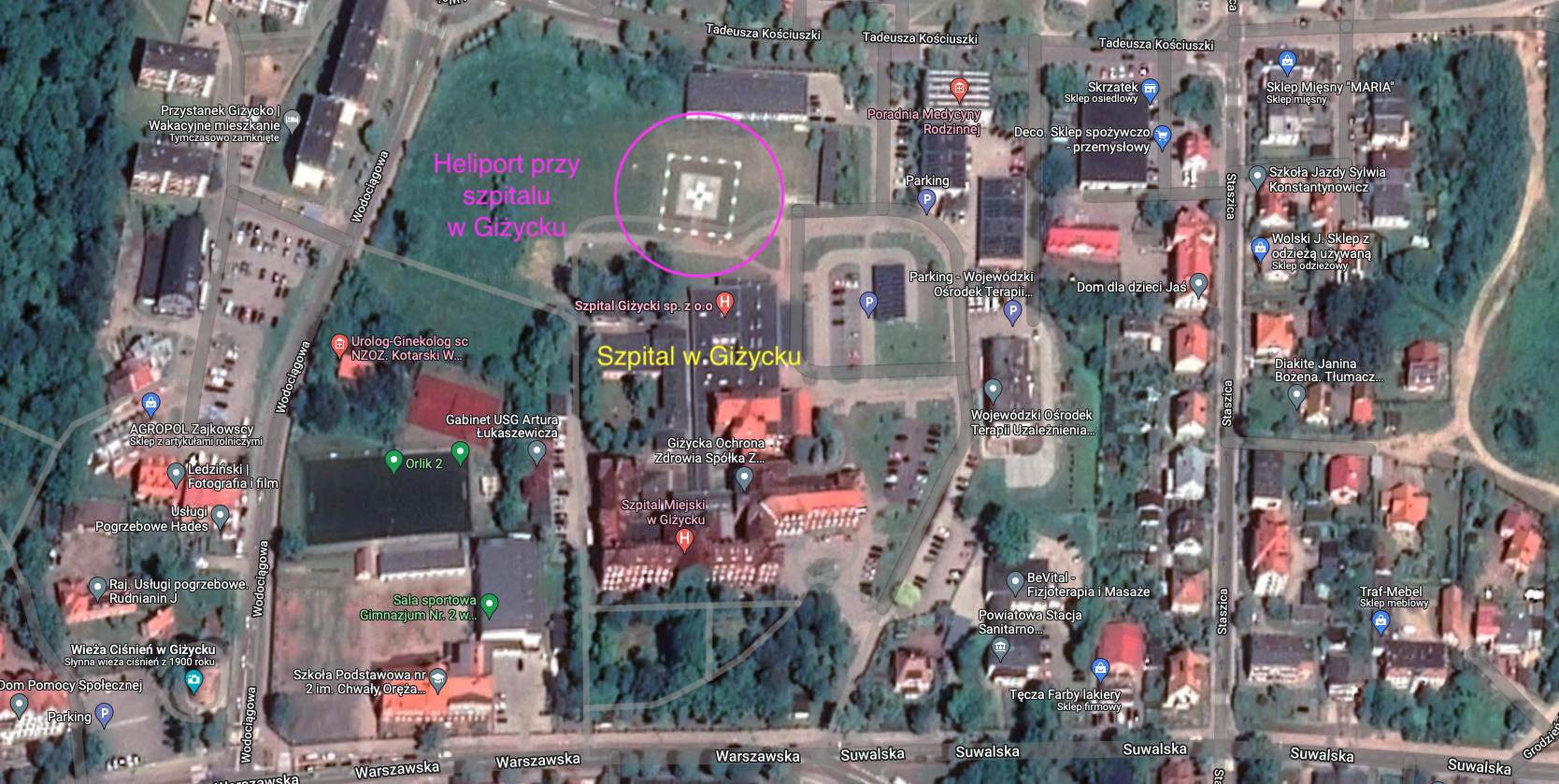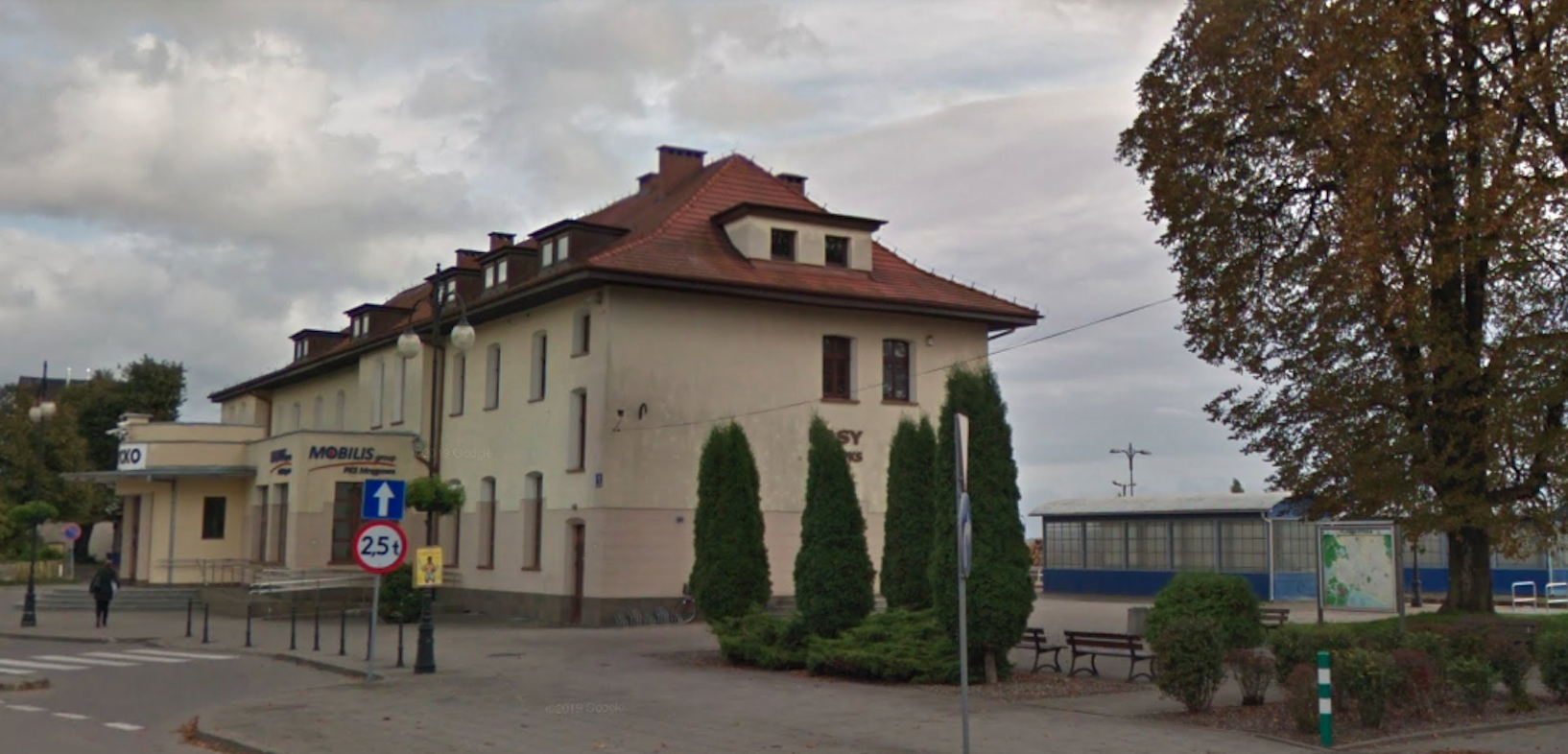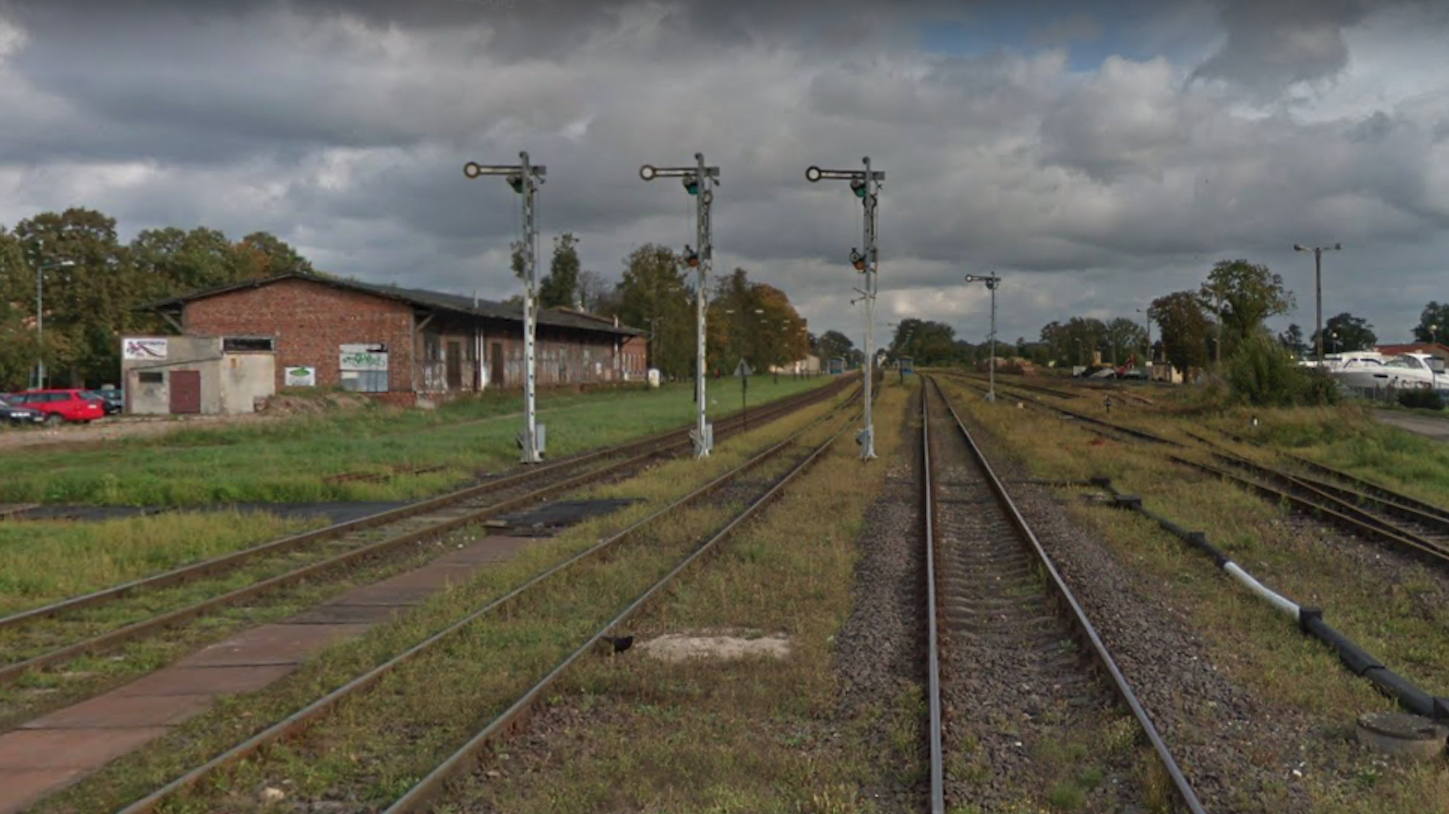Giżycko 2022-01-01
Giżycko Railway Station.
Geographic coordinates: 54.031N 21.778E.

Description of the photo: The city water tower (water tower) with an observation deck is visible in the center. On the left side you can see the hanging pier. The "EkoMarina" is visible centrally at the quay, and the "Go1" railway control station on the right.
The city of Giżycko.
The city of Giżycko is located in Poland in the Warmian-Masurian Voivodeship. The city is the seat of the district and the rural commune of Giżycko. The city of Giżycko has an area of 13.72 km2 and is situated 142 m above sea level. Niegocin Lake is 116 m above sea level. The city is inhabited by 29,642 inhabitants (2016).
Giżycko is located in the central part of the Masurian Lake District in the Land of the Great Masurian Lakes. The city is situated between the lakes Kisajno and Niegocin. For many centuries, the settlement lived by catching fish from Lake Niegocin and other neighboring lakes. The vicinity of Giżycko has the largest number of lakes in Poland. Therefore, in the coat of arms of the city on a blue background there are three bright fish. Giżycko is called the sailing capital of Poland. Giżycko is an important tourist and leisure center.
The city of Giżycko was founded in 1437. City rights were granted in 1612 under the Chełmno law. Historically, these are areas on the border of two medieval Prussian lands: Jaćwieży (Sudovia) and Galindia. After the brutal pacification of these areas by the Teutonic Order, in the period 1277–1283, the population was handed over to the authorities in Malbork. These areas were not economically attractive, but were plundered many times by neighboring tribes. A stronghold was built in the settlement to guard the trade route, which was extended to the form of a castle. Due to the lack of space, the borough was not built, therefore Giżycko did not develop like a typical town. The castle was built in the 17th century, and it is partially preserved to the present day, and there is a hotel in it. Under the Peace of Toruń, the region with the city was part of the Kingdom of Poland as a fief in the hands of the Teutonic Knights. In 1525, Grand Master Albrecht Hohenzollern secularized the Teutonic Order, adopted Protestantism and established a secular principality in Prussia, linked to the Kingdom of Poland as a fief.
During the Swedish Deluge, after the defeat in the Battle of Prostki, where the Prussian army supporting the Swedes succumbed to the Polish army of hetman Wincenty Gosiewski. Lithuanian and Tatar troops that supported the Poles entered Masuria. The castle at Niegocin Lake was attacked by the Tatars on February 10, 1657, destroying the entire city. Only the castle, town hall and church survived. The city practically ceased to exist. Pursuant to the provisions of the Welaw-Bydgoszcz treaties of 1657, Poland lost its control over the region and the city of Giżycko became part of the Brandenburg-Prussian state, transformed in 1701 into the Kingdom of Prussia.
The city of Giżycko (Lötzen) was not spared by famines, epidemics and fires. It was one of the poorest cities in the Kingdom of Prussia. In 1710, most of the town's inhabitants died as a result of a plague epidemic. Until 1820, the city of Giżycko had district authorities in the city of Ryn. This year, the starost of Ryn moved to the castle in Giżycko (Lötzen). In 1822 the city was consumed by a great fire.
It is worth mentioning that the Prussian king, Frederick William IV, also used the Polish language, which was common in Masuria. In 1838, Wojciech Kętrzyński, a Polish historian, long-time director of the Ossolineum, was born in the city of Giżycko.
The establishment of the German Empire in 1871 brought changes to Masuria. A favorable law was introduced for the settlers. The population increased. The second half of the 19th century brought an improvement in the quality of life of the inhabitants of Giżycko (Lötzen). At that time, the construction of the Boyen Fortress, the construction of hard road roads and railroads began. At the same time, many other facilities and workplaces were created.
During the Great World War, they unsuccessfully tried to capture the Muscovites twice on the Boyen Fortress. Battles in these areas lasted from the fall of 1914 to the spring of 1915. Efficient rail transport played an important role in supplying the Prussian army.
After the Great World War, referenda were held in Masuria. Most of the inhabitants were in favor of staying in East Prussia. In 1939, Giżycko was already a well-known holiday resort. Even residents of Berlin, Szczecin and Bydgoszcz came here. A network of hotels, guesthouses, restaurants and cafes was developed in the city. A large yacht marina and a bathing area on Lake Niegocin were built. Rowing, sailing and ice yachting regattas were organized. Hunting for waterfowl was organized. According to the 1939 census, Lötzen (Giżycko) had 16,288 inhabitants.
But the stupid Germans started the Second World War with the Moskal brothers. The war came to the city of Giżycko at the end of December 1944, with the first raids of the Soviet air force. The attack on the ice, from the side of the frozen Lake Niegocin, surprised the German troops and forced them to surrender. The city was seized by units of the 44th Corps of the 31st Army of the Third Belorussian Front. 1,715 Soviet soldiers were buried at the local cemetery. For the next four months, Giżycko (Lötzen) was destroyed and plundered by Moscow soldiers.
On May 20, 1945, the Soviet military headquarters handed over the city and county administration to the Polish authorities. The first group of Polish settlers was brought to Giżycko from the Białystok regions. Later, displaced people from the Vilnius Region and other Polish Borderlands arrived. The deportation of the German population began in January 1946. Those from Masuria who did not want to agree to the Polish origin and the translation of surnames and names had to emigrate.
After the Second World War, the city was called Lec. Soon, however, the name Łuczany was used (August 1945), in reference to the original name Łocze - Lötzen in German. On March 4, 1946, the Commission for Establishing the Names of Places gave the town the name Giżycko in honor of Gustaw Gizewiusz (family name Giżycki).
In Giżycko, tourists can meet several attractions: Rotary bridge on the Giżycki (Łuczański) Canal. Boyen Fortress. A water (water) tower from 1900, open to the public, with an observation deck. Saint Bruno's Hill with a cross from 1909.
Airports and landing sites.
On the outskirts of Giżycko, outside the city, there is the Mazury Residence Airpark & Marina estate. The estate has a runway for sports and tourist aircrafts and a yacht marina at Lake Niegocin. The landing field is called - Giżycko Mazury Residence landing field. The landing strip is ICAO registered: EPGM. The name Grajewko is also used. Runway 860 m x 50 m. Direction 110/290. Elevation: 410 ft = 125 m. Geographic coordinates: N54 ° 00'19.6 "E21 ° 49'16.7". Grass strip, marked. The whole area is fenced. South circle 300 m above the ground. Sleeve halfway on the north side. The landing strip is officially closed with NOTAM, but it is actually in operation. ULC 133. A few private residences have been built on the airport grounds.
In the north-west direction from Giżycko, about 2 km away, there is the Antonowo landing field, also known as Giżycko. Geographic coordinates: N54 ° 03'29.4 "E21 ° 44'48.9" Elevation: 390 ft = 119 m. Unpaved runway 435 m x 40 m, direction 040/220. The landing field is private. Telephone contact with the owner is required prior to arrival The landing field is mainly used by motor hang-gliders.
In the north-east direction from Giżycko, at a distance of about 5 km, there is the Bożykowo landing site, which is also called Spytkowo. Geographic coordinates: N54 ° 04'29.4 "E21 ° 50'05.3" Elevation: 491 ft = 150 m. A dirt runway measuring 294 m x 35 m, in the direction of 024/204, intended mainly for powered hang-gliders. The landing site is not marked and is privately owned, it is necessary to contact the owner by phone prior to arrival.
In 2013, a heliport was opened at Warszawska Street, located at the City Hospital in Giżycko.

Giżycko Railway Station.
The Giżycko railway station was opened in 1868. The first scheduled train entered the station on December 8, 1868, from the direction of Kętrzyn.


Description of the photo: View from the railroad crossing along Dąbrowskiego Street towards the Giżycko station, towards the east.
The station was located on a narrow strip of land between the city and Lake Niegocin. For the construction of the station, land was purchased from their owners. The station building was built identical to the one in Kętrzyn. However, as a result of the Great World War, the building was damaged and was rebuilt. As a result of the reconstruction, the building received a new roof, with a large slope and a landscaped attic. In 2005, the city became the owner of the station. In 2006, the building was renovated and is the showcase of the city. It was the first railway station in the Warmian-Masurian Voivodeship taken over by the local government from PKP S.A. The example of Giżycko inspired other local governments to talk with the railway about changing the image of local stations. On July 7, 2006, the railway station in Giżycko was officially opened. A parking lot was built, green areas and small architecture were established. The renovation cost PLN 1,200,000. In 2008, the city of Giżycko renovated the second railway station building for PLN 560,000. There are toilets and showers in the building. The facility is accessible for disabled people and for families with young children. The station area is monitored 24 hours a day by 8 cameras connected to the municipal system of the Crisis Management Center.
The Giżycko station received three platforms. Generally, Platform 1 served trains towards Kruklanki, Platform 2 served trains towards Ełk, and Platform 3 towards Orzysz. However, each platform served trains towards Kętrzyn. A passenger tunnel has been built under the platforms. In 1946, Platform 3 was closed, because the mosques demolished the track on the Giżycko - Orzysz line. PKP did not have the funds to rebuild this route.
The platforms are of a low type and the surface is made of small paving tiles and cobblestones. There have never been roofings on the platforms. There is one track at Platform 1 and it is the main track No. 1. The track between the station and Platform 1 has been liquidated. There are two tracks at Platform 2. The station has seven more freight tracks and five sidings. There is a freight ramp in the eastern part of the station. There are also warehouse buildings.
A small locomotive was built at the Giżycko station. It is currently closed. Railway traffic is served by two signal boxes "Go" from the east (direction Ełk) and "Go1" from the west (direction Kętrzyn). The stations are serviced by railway crossings along Jeziorna (east) and Dąbrowskiego (west) streets. There are shaped semaphores at the station.
The station has not been electrified. Currently, the railway line No. 38 Białystok - Głomno is being modernized in order to maintain its route parameters, mainly the speed of passenger trains of 120 km / h.
For many years, the station was served by steam locomotives. Ty2 locomotives were the most numerous here. In the 1970s, diesel locomotives were seen here: ST43, ST44, SM42, SU42. Recently, the Pesa Gama SU160 diesel locomotives and the Newag SM4210 dual-aggregate locomotives have been seen here.
In 2018, the Giżycko station served up to 1,000 passengers per day during the holiday season. Outside the holiday season, passenger traffic is lower. Currently (2022) from the Giżycko station it is possible to depart to: Ełk 4 pairs of trains a day PolRegio. Gdynia 1 pair of "Niegocin" InterCity trains. Olsztyn Główny 5 pairs of trains a day PolRegio. Wrocław Główny 1 pair of "Mamry" InterCity trains.
Electrification and modernization.
In 2022, the reconstruction of the route on the section Ełk - Korsze, on a length of about 100 km, began. The route is to be electrified, which will allow the train to run at a speed of 160 km / h. The planned investment assumes that travelers will have 4 more accessible stations (Sterławki Wielkie, Kętrzyn, Tołkiny and Korsze) and 5 stops (Niegocin, Sterławki Małe, Martiany, Nowy Młyn, Linkowo). The platforms will be adapted to the needs of people with reduced mobility. As part of the investment, tracks and railway traffic control devices will be replaced. The increase in the level of safety will be ensured by the reconstruction of 38 rail-road crossings and 84 engineering structures, bridges and viaducts. There will be a road viaduct in Sterławki Wielkie. Efficient train traffic will be enabled by the local control center in Korsze. As part of the first stage of the investment, the first works related to the electrification of the route begin on the Ełk - Giżycko section. The value of the works is PLN 649 million. The planned completion of works is 2024.
Railway lines in Giżycko:
Railway line No. 38 Białystok - Głomno. In 1948 the line was No. 507 and in 1988 No. 510. The line is 241.535 km long, single-track, partially electrified (3 kV). The maximum speed on the line is 120 km / h. The line runs in north-eastern Poland. The line was established in the times of Royal Prussia. The first part of the line was opened on September 24, 1866 from Królewiec to Bartoszyce, then on November 10, 1867, the Bartoszyce - Kętrzyn section was opened, and on December 8, 1868, the Ełk - Kętrzyn section was opened. On November 1, 1871, the section from Ełk to Prostki was opened. In 1873, on the side of the Ruthenian Empire, the Białystok - Grajewo section was commissioned, and on September 15, 1873, the Grajewo - Prostki section was opened, where the standard gauge track ran parallel to the Ruthenian track. After the Great World War, the former Ruthenian part of the line was transferred to Poland, and therefore the Russian track was rebuilt into a standard track. Currently (2022) the line is being modernized.
The non-existent railway line No. 54 Giżycko - Kruklanki. The line was launched on December 21, 1905 as a branch of the Białystok - Głomno line. It was 11,402 m long. It was single-track and non-electrified. In the period May - June 1945, the line was dismantled by the Soviet trophic troops. Around 1951, the line was rebuilt and received No. 589. In 1952, passenger services were launched on the line. In 1988, the line was No. 509. On September 1, 1987, passenger rail traffic was stopped. Freight traffic was stopped in November 1987. In 2002, the line was dismantled. Currently, in 2022, you can easily recognize the track mark.
The non-existent railway line Giżycko - Kruklanki - Węgorzewo. The line was opened on December 21, 1905. The line was single-track. In 1945, there was a physical liquidation of the line by Soviet trophic troops. In the post-war years, the line was rebuilt only on the section Giżycko - Kruklanki. The line ran through: Kożuchy, Pieczonki, Kruklanki, Wyłuchy, Pozezdrze, Ogonki do Węgorzewo.
There was also the Kruklaki - Olecko line. The line was single-track. The line ran through: Brożóka, Jurkowo, Grądzkie, Orłowo, Wronki Mazurskie, Gryzy, Doliwy, Gordejki to Olecko. This line, also in 1945, was liquidated by the Soviet trophy units.
The non-existent railway line Giżycko - Orzysz. The line was opened on June 1, 1906. The line was single-track. In 1945, there was a physical liquidation of the line by Soviet trophic troops. The line ran through: Upałty, Ruda Staświny, Miłki, Konopki, Ublik, Pianki. Currently (2022), traces of the former track can still be found.
Written by Karol Placha Hetman
